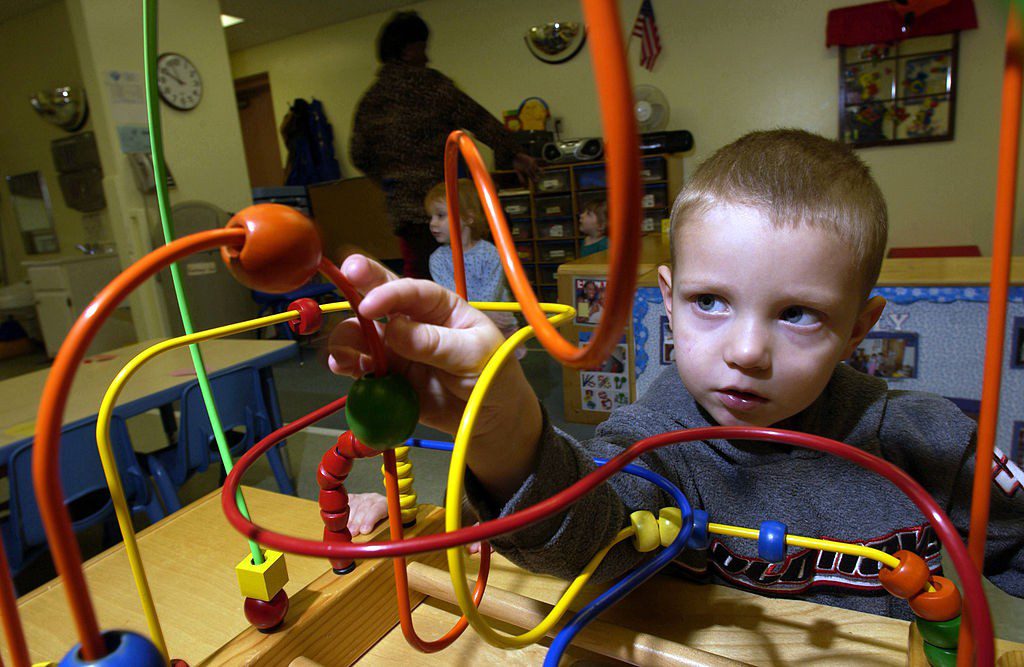![https://commons.wikimedia.org/wiki/File%3AHOUSEWIFE_IN_THE_KITCHEN_OF_HER_MOBILE_HOME_IN_ONE_OF_THE_TRAILER_PARKS._THE_TWO_PARKS_WERE_CREATED_IN_RESPONSE_TO..._-_NARA_-_558298.jpg; By Villalobos, Horacio, Photographer (NARA record: 8464479) (U.S. National Archives and Records Administration) [Public domain], via Wikimedia Commons](https://wp-media.patheos.com/blogs/sites/533/2016/08/1024px-HOUSEWIFE_IN_THE_KITCHEN_OF_HER_MOBILE_HOME_IN_ONE_OF_THE_TRAILER_PARKS._THE_TWO_PARKS_WERE_CREATED_IN_RESPONSE_TO..._-_NARA_-_558298-1024x688.jpg)
Answer: when it’s a certain type of policymakers talking about women’s earnings, employment, and retirement.
They measure women’s labor force participation. They discuss the long-term costs of forgoing employment, when their children are young. They worry that women have inadequate retirement savings, and measure their assets relative to men’s.
These are all questions that are connected up not just with women being mothers, but being, still more often than not, for a significant part of their working (and parenting) lifetime, wives, who make finance-related decisions in partnership with their husbands and will generally consider “their” finances to be the family finances, rather than adding up their own income and assets as separate in any way from their husbands’. How does that line go? “What’s yours is ours, and what’s mine is mine” — expressing the (stereo)typical money-management approach of at least an older generation like my parents, in which his income funded their daily needs, and her (part-time) income funded her splurges. (Well, I don’t really know what they did in that respect — mom & dad had, and still have, a confusing combination of his, hers, and his & hers bank accounts, but I never had a sense that one or the other of them had more “spending money” for their hobbies or purchases than the other, other than them working out what was and wasn’t in the budget.) And in the year 2018, well, I suppose this may have diminished somewhat — at least based on advice-columnist evidence, since periodically there are letters from women bemoaning that their husband makes more, and still demands that each of them pay into their joint expenses equally, and then he runs off on golf weekends. I can’t say that I recall seeing such a letter from a mother, though, so I’ve always assumed that separate finances disappear when the family finances include daycare, or when one party reduces hours or leaves work entirely, and that even if separate bank accounts are maintained for some practical reason or another, the couple still thinks of their assets as shared, rather than a husband saying, when his wife trudges off to work at the age of 75, “too bad, so sad, guess you should have saved more for retirement.”
(Disclaimer: I can’t find any data online regarding the actual frequency with which couples keep finances separate.)
Now, granted, this isn’t the case for all women.
There are, after all, women who choose to have children regardless of whether or not they have gotten married. I’m not talking – yet – about those who unexpectedly become pregnant, but those who seek motherhood, and who choose sperm donors, or treat the fathers of those children as if they were sperm donors, and have no more interest in having those men involved in their lives, or paying child support, as they would a sperm donor. This is your generic mother of a children’s novel protagonist — at least it seems to me that a favorite set-up is the child who’s never known his father and that’s just fine with everyone involved. Such a woman, compared to a similarly-situated man, who is much less likely to seek out parenthood, will invariably be worse off financially; even though she presumably isn’t dropping out of the labor force, she’s likely to cut back hours, and be able to save less simply because, duh!, she has a child to support.
But what is Society, or The Government, supposed to do about this? Do we have an obligation to “make her whole”?
Then there’s the more usual case of single parents, with an identified father — and dad is indeed supposed to be paying child support that’s the equivalent to half the cost of raising a child, adjusted for income levels. Not sure that the government should be doing anything more to make things “fair.”
Which leaves married parents.
And here’s where it bugs me that policymakers want to treat husbands and wives as two separate individuals who just happen to be living in the same household.
In part, they say, women need to advance in their careers as aggressively as men, and build up assets they own individually, so that someday when the marriage dissolves, they can continue on as individuals with no financial harm. And they’re not wrong when they say that women are at risk of financial harm befalling them if their husbands trade them in for younger models, or mistreat them in such a manner that, however committed they are to the institution of marriage, they need to leave their own marriage, and that such events are not predictable or avoidable just by being religious enough or committed enough or a “good enough” spouse.
But the solutions on offer for women — which basically work out to “live your life as if your husband will leave you at any time” — just don’t work for families in their day-to-day life. It’s like asking someone to buy insurance, but at a price that’s so high that it up-ends their life.
The majority of families with young children choose to have a family member, not a paid professional, care for their children at least most of the time. The latest data reports that, of married mothers with children under age 1, only 39% work full-time, with the remainder working part-time (fewer than 35 hours) or not at all. The rates, not surprisingly, climb for mothers of older children;
42% of mothers with children age 1 year,
46% of mothers with children age 2 years,
45% of mothers with children aged under 6 years (yeah, I don’t know why there’s the drop),
and 56% of mothers of children above age 6 work full-time. (Women with no children at home were less likely to work full-time, presumably because they are more likely empty-nesters who are making their way into retirement.)
(Surprisingly, the rates were only a percentage point or two lower for the split out of married mothers — presumably that’s because of the varied situations of these women, many of them either living with a boyfriend or with family, with some stereotypical welfare queens mixed in.)
This is all courtesy the most recent BLS report on employment, and, yes, you might say that I’m “cheating” by including part-time workers with non-employed mothers, but I think it’s important to recognize that this status is a rejection of the push to work full-time, even if it’s not a full-blown “stay-at-home mom” life.
So here are my gripes:
First gripe, all of the efforts to make it easier on the finances for mothers to work, and work full-time, are fine when it’s a matter of lifing a family out of poverty or low-income-ness, but not so much when we’re talking about subsidizing middle- or even upper-middle-class families’ daycare choices, in ways that end up pushing women into full-time work who’d really rather not, either because taxes increase, or because they feel like suckers for not taking advantage of free childcare, or because resources for women with children at home (community-sponsored playgroups, for instance) disappear.
Second gripe is the implied deficiency of non-employed (or non-full-time-employed) women; a lot of what I’m reading still has a component of “women are letting their brains rot if they’re not working full-time and pursuing career advancement,” though, yes, this is the accumulation of a lot of reading, rather than some specific article I can quote from.
Third is with the idea that our economy is by definition better off, when more people work, and they work longer hours. Yes, it increases the GDP, and every politician wants a larger GDP, but does it improve quality of life? In Japan and Germany, boosting the labor force is an important goal because they’re seeking more workers to keep the economy humming when the population (at least until automation takes over) becomes disproportionately older. They are also operating under the theory that women’s labor force participation rate increase are a good proxy for the extent to which mothers are able to stay in the workforce, and they think women will have more children if they are able to stay in the workforce while doing so. But, though our own fertility rate is decreasing, we don’t have the same issues.
Fourth gripe, and what motivated this post in the first place, is the fact that the focus on measuring individual income and assets rather than household finances reinforces the notion that family ties are all just temporary associations that don’t mean anything. I mean, look, I get it, there’s no easy way to take statistics on women’s vs. men’s income and assets, and wave a magic wand to cook the numbers into something that reflects, “this group of women in practice shares their husbands’ earnings and assets, so they’re OK, but this other group here can’t, so we’re going to worry about them.” But I’d still like to see a different path forward.
And there is a legitimate question of how income and asset growth should be divided, not just when a marriage is dissolved, but throughout married life. It seems to me that at least some countries (maybe Switzerland?) take the earnings of a married person and, for Social Security purposes, credit half to each spouse as its being earned, rather than coming up with ways of “sharing” the benefit post-divorce or in retirement. Maybe I’m just making that up, but it seems like a good idea. It would likewise seem like a good idea for IRAs and 401(k)s to be jointly owned automatically, though I suppose employers would freak out at the idea of taking it a step further and creating parallel spouses’ accounts for their employees. And how this all connects up with community property in the various states where this is the law, I don’t know.
Image: https://commons.wikimedia.org/wiki/File%3AHOUSEWIFE_IN_THE_KITCHEN_OF_HER_MOBILE_HOME_IN_ONE_OF_THE_TRAILER_PARKS._THE_TWO_PARKS_WERE_CREATED_IN_RESPONSE_TO…_-_NARA_-_558298.jpg; By Villalobos, Horacio, Photographer (NARA record: 8464479) (U.S. National Archives and Records Administration) [Public domain], via Wikimedia Commons












